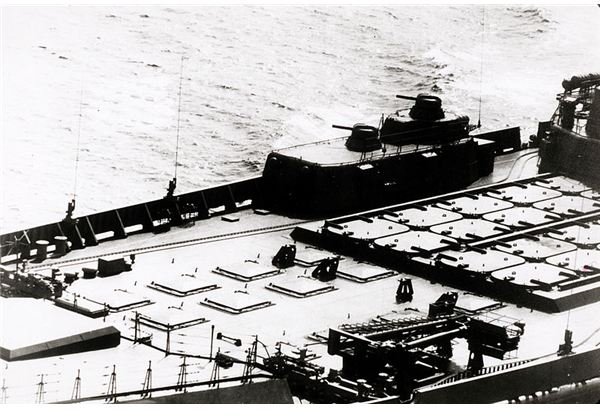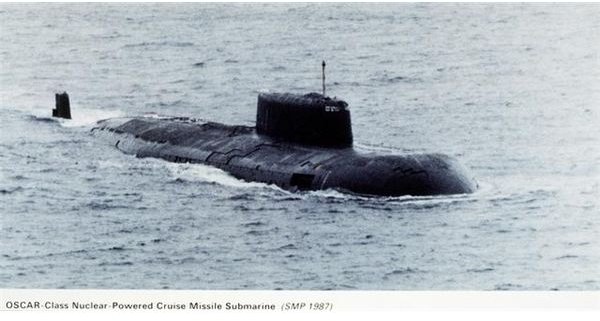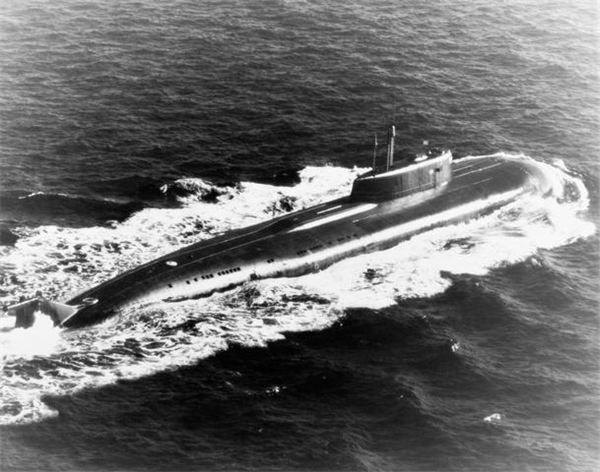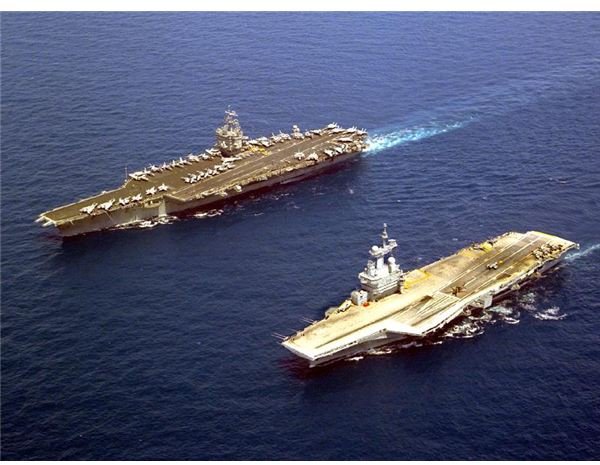Kursk, Member of the Oscar Class - Project 949
The Cruise Missile Submarine
Since the middle of the Cold War it has been realized that one of the best means of delivering a lethal strike to a warship or even a land based installation is to send a cruise missile at it. A cruise missile is essentially an unmanned airplane packed with high explosives - or a nuclear warhead. Unlike ballistic missiles which arc high into the stratosphere before plunging to earth at incredible speeds, cruise missiles can climb, descend, and maneuver just like an aircraft. They have a unique flexibility that allows them to be used against a wide variety of targets and to fly in a manner that makes them difficult to intercept or evade.
The SSGN - nuclear powered cruise missile submarine - is an incredibly stealthy platform for launching a cruise missile. Moving almost silently and deep underwater, a cruise missile carrying submarine can sneak close to its target and fire off a volley of cruise missiles that strike their target so quickly as to be nigh-uninterceptable. Submarines have been used to launch cruise missiles in combat from the Gulf War onward, and usually with terrible effect.
The Soviet Union, facing western naval powers heavily equipped with aircraft carriers, faced a significant challenge if it hoped to counter the immense firepower of an aircraft carrier battle group. Its answer - equip everything that could fly or float with cruise missiles in sufficient numbers to overwhelm a cvbg’s defenses. The Oscar II class was the pinnacle of the undersea arm of this strategy, and each submarine in the class carried up to 24 powerful SSN-19 Granit missiles.
Kursk: Later Member of the Oscar II Class
Thirteen Oscar IIs were completed, and Russian submarine K-141 Kursk was the eleventh of that type. Like his brethren, Kursk was over 500 feet long and approximately 60 feet wide. Powered by two nuclear reactors, the vessel could attain a speed of approximately 32 knots underwater.

Capable of carrying 28 torpedoes in addition to its two dozen cruise missiles, any Oscar class submarine was an exceptionally dangerous foe for any aircraft carrier battle group. Filled with sound absorbing materials in between its two pressure hulls a member of the Oscar class could quietly place itself in the path of an advancing carrier battle group, almost silently creep into a firing position, and unleash a devastating missile and torpedo strike against carriers or other high value targets in the area.
The torpedo tubes commonly used by Soviet built submarines are worthy of note. They typically mounted two different sized tubes each capable of firing slightly different missiles and torpedoes. The larger tubes typically contained special wake following torpedoes that could home relentlessly on the disturbed water left behind a warship in motion. They were larger than other torpedo tubes in order to carry especially large carrier killing torpedoes - yet another design optimization meant to let these powerful submarines tackle current and future aircraft carriers.
Kursk’s Last Voyage - Torpedo Testing
Even though the Cold War was long over, the Russian Navy continued to develop weaponry and refine its skills during the tough decade after the dissolution of the Soviet Union. Weakened by perpetual budget shortages that kept most of its fleet rusting in port for want of funds, by 2001 the Russians were more economically stable and able to inject new money into the fleet. Training exercises were held, and new weapons tested.
Along with a Kirov Class battlecruiser, the Pyotr Veliky, Kursk sailed on August 10th, 2001 into the Barents Sea where she was to test two new torpedo designs. Two US submarines and a UK submarine were in the area, but all kept their distance from the live fire zone set up for the Kursk to launch the experimental torpedoes.
Seismic sensors in Europe and sonar records from the battlecruiser provided the first indication that something was wrong aboard the Kursk.
How the Submarine Kursk Sank Into the Depths of the Barents Sea: Torpedo Explosion to Blame
It took what amounted to a forensic investigation to determine what likely happened to the Kursk as the submarine began the exercise. It appears that a poor seal separating volatile chemical compounds within one of the torpedoes to be tested caused them to mix and react catastrophically.

Russian submarines are built tough, and experts actually believe that the Kursk could probably have survived an isolated explosion in one of the torpedo tubes. However, wear and tear on the torpedo tube inner door likely lead it to fail under the force of the torpedo’s explosion, which channeled the deadly blast into the torpedo room behind it and admitted seawater into the compartment.
Shocked by the jarring explosion, the crew of the stricken submarine couldn’t react as the rapidly flooding torpedo room brought the ship to the bottom of the Barents. However, the Kursk submarine sank in relatively shallow water - any crewmembers not killed in the immediate explosion might have been able to stabilize the situation and escape - or even refloat the sub. But the explosion of one torpedo in the forward torpedo room was not the only detonation to occur in the stricken submarine Kursk. A series of up to seven secondary explosions registered on Pyotr Veliky’s sonar equipment. The catastrophic detonation of these weapons as the submarine sank ripped open the pressure hull and killed every member of the crew forward of the reactor spaces - more than eighty sailors.
Russian Submarine K-141 Kursk Crew’s Last Hopes
Kursk’s reactors automatically shut down to prevent a meltdown and the surviving crew rapidly retreated to the aftmost compartment on the submarine. After sealing the vital watertight doors leading to the rest of the ship, the roughly two dozen survivors faced a grim situation. They only had a few hours of oxygen left and the Oscar II class submarines always slowly leaked water into the stern - leakage that was normally counteracted by electric pumps but which was inoperable while the reactors were offline. Escape via an emergency hatch was theoretically feasible, but the hatch might have been damaged or the crewmembers may have been too injured to escape through the cold water. And they had one overriding hope: a rescue submarine could be dispatched to attach to the escape hatch and allow rescuers to come to their direct aid.
.

But sadly, in a mad tangle of bureaucracy, latent Soviet-era paranoia, and an ill-placed confidence in its own capabilities the Russian Navy acted too slowly to mount a rescue effort and refused offers of help even from its neighbor Norway. The condition of the Russian navy was too deteriorated even to effectively send a rescue submarine to aid the Kursk survivors, and so the few remaining spent their last hours in darkness and increasing cold, with one officer scrabbling the names of those left alive in the doomed vessel so that recovery efforts would at least be able to identify some of the bodies.
The rescue was too long in coming. By the time the Russian government got over its hesitation and allowed foreign help to arrive, it was too late. All 118 crewmembers of the submarine Kursk lost their lives in the eighth worldwide loss of a nuclear powered submarine.
Submarine Kursk Sources, Image Credits, and Further Reading
Sources:
Peter Davidson, Huw Jones, John H Large: The Nuclear Hazards of the Recovery of the Nuclear Powered Submarine Kursk accessed 4/28/2011
John Jordan: An Illustrated Guide to the Modern Soviet Navy; 1982 Arco Publishing
A Wordsworth Colour Guide Modern Warships; 1993 Wordswordh Editions LTD
Image Credits:
All Images courtesy of the United States Government, accessed via Wiki Commons.
For Further Reading:
Another naval disaster was the loss of the HMS Hood to the Bismarck with all but three of her crew. Information about the targets of the Kursk, aircraft carrier battle groups, is also on Bright Hub. And the Kirov Class battlecruisers of which Pyotr Veliky is the primary active member are also profiled on this website.
